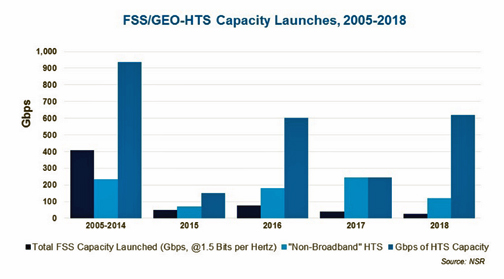
In the eight years since NSR coined the phrase HTS, High Throughput Satellites have gone from being a rarity to being commonplace.
Indeed, from the time that the first all-HTS payload—Thaicom-4/IPSTAR—was launched in 2005, until today, there has averaged only around 1 HTS launch per year. As we move further into the GEO-HTS era, the industry is being turned on its head by more capacity launching than ever before.
NSR’s recently published Global Satellite Capacity Supply & Demand, 13th Edition delves into this industry shift in emphasis, with significant analysis and forecasting of current and future capacity launches. Overall, the trend is undeniable that the satellite industry is now reaching the point where HTS is the norm.

As this chart shows, when all capacity is converted to Gbps (with traditional FSS TPEs using a 1.5 bits per hertz ratio), the period of 2005 to 2014 saw around 400 Gbps of traditional FSS capacity launched. This compares to around 950 Gbps of GEO-HTS capacity, with the caveat being that much of this GEO-HTS capacity is large, consumer-broadband focused satellites, with the three biggest currently being ViaSat-1, EchoStar 17 (AKA Jupiter-1), and Eutelsat KA-SAT. When taking out these high volume, low margin satellites, NSR nonetheless counts around 200 Gbps of GEO-HTS capacity launched from 2005 to 2014, or around half of the amount of traditional FSS capacity launched.
Moving forward, however, this trend will very clearly reverse, with GEO-HTS seeing significantly more overall capacity launched, even when taking out programs such as NBN Co. in Australia and ViaSat-2/Jupiter-2 in the US (which are not included in the “Non-Broadband” HTS Capacity). Indeed, 2015 saw around 80 Gbps of Non-broadband HTS launched, with 2016 expected to see nearly 200 Gbps. Thus far, there is around 250 Gbps of non-broadband GEO-HTS capacity announced for launch in 2017, or alternatively, more than the amount launched between 2005 and 2014.
While video markets will remain more or less insulated from this capacity due to the real value in point-to-multipoint via widebeam capacity, data markets will see changes come about in a big way due to what is an exponential increase in the amount of supply available. NSR has for some time discussed the pricing implications of this new capacity, and from an operator perspective, it is a precarious yet logical path to drive down price points in order to expand addressable market.
GEO-HTS payloads see dramatically lower CAPEX per Gbps, which should allow for lower pricing, and operators will need to invest in new ways to sell this capacity moving forward. With that in mind, in some instances, even negative revenue growth could lead to positive growth in operating cash, due to the aforementioned lower CAPEX per Gbps of supply to launch. Put another way, if a satellite operator can replace 3x $300M FSS satellites with 1x $500M GEO-HTS satellite on a like-for-like basis in terms of capacity and demand profile, then lower total revenues could still spell a solid return on investment, and stronger cash flows.
This will, if nothing else, be a highly delicate balancing act to be performed by operators, as GEO-HTS becomes the norm and as price points come down significantly. Anecdotally, Telesat referred to this phenomenon in their recent Q2 earnings calls, during which time Telesat referenced a recently agreed-to contract for pre-launch capacity on Telstar 19 Vantage, which the company noted was at a lower price point and was for a customer that had previously been with a competitor. Beyond this, Intelsat’s Q2 earnings call referred to major disruptions being brought by EpicNG pricing to markets where Intelsat itself is a major player.
GEO-HTS has been around for over a decade now, and up until approximately last year, the technology did not disrupt traditional FSS data markets in a very meaningful way. However, this is beginning to change, with 2015 being the first year since IPSTAR in 2005 in which more “non-broadband” GEO-HTS was launched than traditional FSS, and it is unlikely that we will ever again see traditional FSS capacity growth out-pace GEO-HTS in a given year.
Recent earnings calls have made it clear that pricing disruptions coming about from this trend are here to stay, and that operators will need to swiftly change their business models in order to capture new market share and maintain revenues and market positioning.
Additional information regarding this report is available at this direct link...

Article by Blaine Curcio, Senior Analyst, NSR Japan


